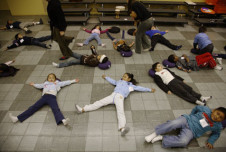Every day we hear stories in the news of how our schools are failing kids. The disparity between students who achieve high test scores and those who don’t mirrors the division in our society between the “haves” and “have nots.” Children who for one reason or another can’t sit still, focus, or get along with their peers continue to fall behind academically, while concerned parents and teachers feel overwhelmed, not knowing how to intervene effectively.
In his new book, The Way of Mindful Education, Daniel Rechtschaffen argues that there is something simple that can be done to help change this: teaching mindfulness in schools. Rechtschaffen, a leading mindfulness educator and founder of the Mindful Education Institute, believes that mindfulness training can increase social-emotional skills—like attention, empathy, forgiveness, and impulse control—that help improve the classroom social climate and increase academic performance for kids.
Research on mindfulness has proliferated in recent decades, and the results are promising, according to Rechtschaffen. Practicing mindfulness has been shown to decrease pain, stress, depression, and anxiety, while increasing happiness and improving interpersonal relationships…at least in adults. Research with children, though more preliminary, suggests that teaching kids mindfulness skills may help decrease symptoms of ADHD, depression, anxiety, and hostility, while increasing self-esteem and sleep quality, all of which has an impact on learning.
Rechtschaffen’s book is primarily a ”how-to” for creating a mindful classroom. He suggests ways that teachers can become more mindful themselves so that they can role model the type of attention, self-control, and consideration they wish to see in their students. He also provides guidance for how mindfulness can be incorporated into classrooms of different age groups and needs, along with examples of mindfulness curricula that teachers can use in various settings.
However, Rechtschaffen warns against teachers using mindfulness exercises in their classrooms without first developing their own practice.
“We often leap forward, wanting to help our kids relax, forgetting to notice how anxious and in need of relaxation we are,” he writes. “A teacher would never try to lead a math lesson if she didn’t know the multiplication tables.” Similarly, teachers trying to teach mindfulness won’t get far with their students if they first don’t model good emotional regulation and sensitivity toward their students’ needs, he argues.
In fact, Rechtschaffen claims that teachers may need mindfulness training more than their students.
“Year after year I have watched schoolteachers entering the classroom on the first day as hopeful and inspired as a child taking its first steps” he writes—only to give up soon after. Mindfulness can help teachers feel reinvigorated and provide benefits to students indirectly, since teachers who are more mindful may be more attuned, compassionate, and flexible with their students.
 Our Mindful Mondays series provides ongoing coverage of the exploding field of mindfulness research.
Our Mindful Mondays series provides ongoing coverage of the exploding field of mindfulness research.
Still, a large part of his book is devoted to providing sample mindfulness lessons that can be used in classrooms or youth programs. The lessons progress though four areas of mindfulness:
- Embodiment: learning how to feel comfortable and relaxed in one’s body;
- Focused attention: attention to sensory phenomena, such as one’s breath or sounds in the environment;
- Heartfeltness: learning to feel one’s emotions and to regulate more difficult ones;
- Interconnection: bringing compassion, forgiveness, and gratitude into one’s life.
For each area, there are suggested exercises for developing these skills in kids, along with reasons why it is important to learn.
Though some educators may feel that it’s too much to add on to their already overcrowded lesson plans, Rechtschaffen suggests that teaching mindfulness saves time and aids students in the long run. “When students don’t know how to pay attention or regulate their emotions, they easily fall into distracting behavior, often out of sheer frustration,” he writes. “As teachers, if we can offer these students the inner resources that they are lacking rather than penalizing them over and over, they have a much greater chance of thriving.” And, ultimately, teachers save time, because they don’t have to continually work to bring distracted, disruptive kids back into the learning fold.
Is there any reason not to integrate mindfulness into schools? Rechtshaffen doesn’t seem to think so, even though the research on mindfulness in children is still in its infancy, suggesting that its universal application in schools could be a bit premature. Even so, if current research trends continue, we may all be clamoring to get mindfulness into our schools.









Comments